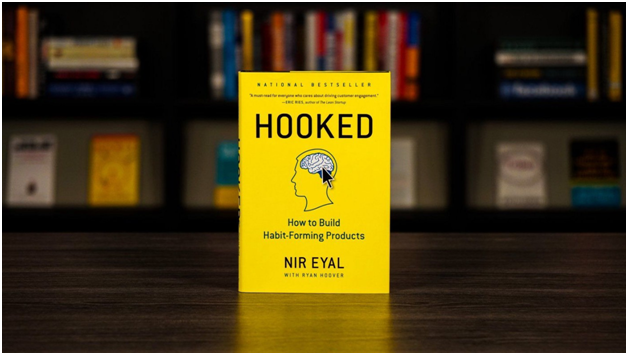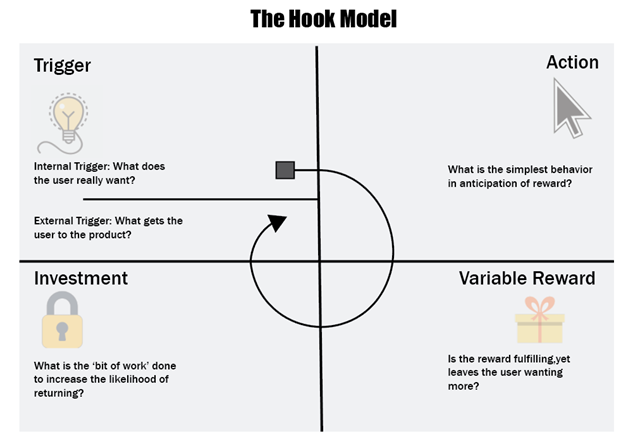Can you keep customers HOOKED on your products? Check out this “Marvel’s” 4 steps to “manufacture” desire! [Monday: Marketing Marvels]

Miles Everson’s Business Builder Daily speaks to the heart of what great marketers, business leaders, and other professionals need to succeed in advertising, communications, managing their investments, career strategy, and more.
A Note from Miles Everson:
Happy Monday!
We hope you all had a good rest.
Let’s start the week by talking about today’s “Marketing Marvel”—an outstanding person in the fields of business and marketing. Every Monday, we feature an exceptional professional and highlight his or her experiences, insights, and contributions to the industry.
In this article, let’s focus on the person who pioneered the idea of making a particular product or service a habit.
Keep reading to know how you can “manufacture” desire for your offerings with the help of this “Marvel’s” framework.
Miles Everson
CEO, MBO Partners
Chairman of the Advisory Board, The I Institute
Marketing Marvels
Do you know someone who’s a “super fan” of social media—Facebook, Instagram, Twitter, etc.?
By “super fan,” we mean that person is HOOKED on social media to the point he or she has formed a habit of checking his or her feed DAILY.
If you do, you might have wondered:
“How did this person become so fond of this social media platform that it has become a part of his/her routine?”
If you’re looking for an answer to your question, this person can help you with that…

Photo from Six Seconds
Nir Eyal is an author, lecturer, and investor born on February 19, 1980 in Hadera, Israel. When he was 3 years old, his family immigrated to the U.S. and settled in a suburb in Orlando, Florida.
He earned his Bachelor of Arts degree at Emory University in 2001. After graduating, he worked for Boston Consulting Group and a solar panel installation firm before taking a Master of Business Administration (MBA) at Stanford University.
After finishing his MBA at Stanford in 2008, Eyal and his friends co-founded a company that placed online ads on Facebook. Eyal served as CEO. His work in their startup business sparked his interest in the psychology of online users, and since then he became a consultant in product design.
In 2012, he taught a course on product design at the Stanford University School of Engineering.
Most of Eyal’s expertise is in behavioral engineering, which incorporates elements of behavioral science into software design to help developers create “habit-forming products” for enterprises.
He has taught university courses, delivered speeches, and published books about the intersection of psychology, technology, and business. His writings were published in Fast Company, Harvard Business Review, The Atlantic, Psychology Today, and more.
Eyal’s first book that he co-wrote with Ryan Hoover, “Hooked: How to Build Habit-Forming Products,” became a Wall Street Journal bestseller in 2014. The title of the book reflects his idea of the “Hook Model,” which helps enterprises build products that create habit-forming behaviors in users via a cycle of trigger, action, variable reward, and continued investment.

Photo from Bootcamp – UX Collective
The Hook Model: Manufacturing Desire in 4 Steps
Eyal believes we’re on a “new era” of the Web. As countless information compete for consumers’ attention, companies are looking for new ways to stay relevant in users’ minds and lives.
Nowadays, amassing millions of followers or customers is no longer good enough. Businesses must also establish the value of their offerings to retain customers.
What is the “Hook Model?”

Photo from UX Collective
This framework is a way of describing consumers’ interactions with a product as they pass through 4 phases: A trigger to begin using the product, an action to satisfy the trigger, a variable reward for the action, and an investment that makes the product more valuable to users.
As consumers go through these stages, they build habits in the process.
Let’s dive deeper into these phases…
- Trigger
This is the spark plug in the “Hook Model” and comes in 2 types: External and internal. External triggers can come in the form of emails, website links, app icons, etc. By clicking on these triggers, consumers begin to form associations with internal triggers that are attached to various emotions.
For example: Let’s say Anna sees a Facebook photo featuring a popular tourist spot in Canada. It’s a good photo and since she’s planning to go there too, the trigger (Facebook photo) intrigues her.
- Action
Here, businesses leverage 2 aspects of human behavior: Motivation and ability. To increase the odds of consumers taking the intended action, the behavior engineer makes the action as easy as possible while simultaneously boosting consumers’ motivation.
Continuing on the example above…
With a click on the Facebook photo (intended action), Anna is taken to a website she’s never been to before: Pinterest. She’s dazzled by what she sees next.
- Variable Reward
Variable rewards are one of the most powerful tools companies use to hook customers. According to several studies, dopamine levels in the body surge when the brain is expecting a reward for a particular action.
Using the same example, when Anna lands on Pinterest, not only does she see the photo she first saw on Facebook, but she also sees a multitude of other interesting photos associated with what she’s generally interested in.
This new information excites her brain with a promise of a reward. This compelled her to stay on the site and continue scrolling for the next wonderful thing to find (variable reward).
- Investment
This phase has 2 goals as far as the behavior engineer is concerned: To increase the odds that consumers will pass through the entire cycle again when presented with the next trigger, and to encourage consumers to act on a certain call-to-action (CTA).
The investment generally comes in the form of money/payment, inviting friends, stating preferences, building virtual assets, and learning to use new features on a site. These CTAs help make the next trigger more engaging, the next action easier, and the next reward more exciting.
Continuing on with the last part of the example, as Anna enjoys scrolling through Pinterest, she builds a desire to keep the things that delight her. By checking out various posts, she’s giving the site data about her preferences.
Soon, she will follow, pin, re-pin, and make other investments to increase her ties to the site and prepare her for future loops through the “Hook Model.”
“Habits are A Superpower”
Eyal once said:
“A reader recently wrote to me, ‘If it can be used for evil, it’s not a superpower.’ He’s right. Under this definition, habit design is indeed a superpower. If used for good, habits can enhance people’s lives with entertaining and even healthful routines. If used to exploit, habits can turn into wasteful addictions.”
This is why Eyal says habit-forming technologies are the “new era” of the Web. As businesses combine the ability to collect and process data at higher speed than ever before, the world is faced with a future where everything becomes more “addictive.”
As a result, the trinity of access, data, and speed creates new opportunities for habit-forming technologies to continue to hook consumers.
Eyal’s bottom line?
Companies must know how to properly harness the power of hooks and habits to improve consumers’ lives. At the same time, consumers must understand the mechanics of behavior engineering to protect themselves from unwanted manipulation.
We hope you find Eyal’s framework insightful and helpful!
As a business owner, leader, or marketer, always keep the “Hook Model” in mind. Only by understanding what truly matters to your customers can you match the right variable reward with the intended behavior.
Are you ready to build products or services that consumers truly enjoy?
(This article is from The Business Builder Daily, a newsletter by The I Institute in collaboration with MBO Partners.)
About The Dynamic Marketing Communiqué’s
“Monday Marketing Marvels”
Too often, industry experts and the marketing press sing the praises of some brand or company’s marketing strategy.
… only for the audience to later find out that its product was a flop, or worse, that the brand or company went bankrupt.
The true ROI in marketing can’t be separated from the business as a whole.
What good is a marketing case study if one can’t prove that the company’s efforts actually paid off?
At the end of the day, either the entire business is successful or it isn’t. And the roles of marketing and communication are always paramount to that success.
Every Monday, we publish a case study that highlights the world’s greatest marketing strategies, marketers, and communicators.
However, the difference between our articles and the numerous ones out there is that we will always make certain that the firm really did generate and demonstrate earning power worthy of study in the first place (compliments of Valens Research’s finance group) in keeping with a person’s leadership skills in the area of marketing and/or communication.
We’ll also study the greatest marketing fails and analyze what they did wrong, or what they needed to improve. We all make our mistakes, but better we learn from others’ mistakes—and earlier, rather than later.
Hope you found this week’s marketing marvel interesting and helpful.
Stay tuned for next week’s Monday Marketing Marvels!
Cheers,
Kyle Yu
Head of Marketing
Valens Dynamic Marketing Capabilities
Powered by Valens Research
www.valens-research.com




